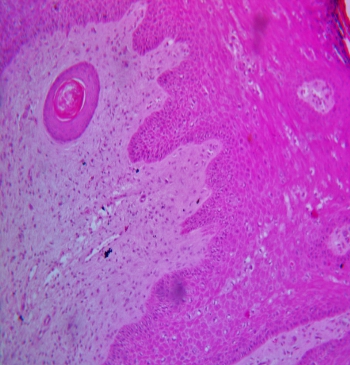Patho-morphological and AgNOR based diagnosis of cutaneous squamous cell carcinoma in buffalo
Keywords:
Bubalus bubalis, buffaloes, mAgNOR, pAgNOR, cutaneous squamous cell carcinoma, Keratin pearlAbstract
A case of cutaneous squamous cell carcinoma was reported in a 4 year old buffalo. Grossly, growth mass was 10 cm long, 7 cm width and 175 gm in weight and located on cranial aspect of left hind limb at fetlock joint. Histologically, the tumour showed irregular mass or cords of epidermal cells that proliferate downward and invade the dermis and sub-cutis. Keratin pearl formation also occurs at some places and it was composed of concentric layers of squamous cell gradually increasing keratinisation towards the centre. The value of mAgNOR and pAgNOR count for cutaneous squamous cell carcinoma was found to be 2.72±1.05 and 30%, respectively. On the basis of gross, histological examination and AgNOR count, the tumour was led to the final diagnosis of squamous cell carcinoma.
Downloads
Metrics
References
Bancroft, J.D. and M. Gamble. 2002. Theory and Practice of Histological Techniques, 5th ed. Churchill Livingstone, USA.
Baniadam, A., N. Moezzi and B. Mohammadian. 2010. Nasal squamous cell carcinoma in a cow. Turk. J. Vet. Anim. Sci., 34(3): 303-305. DOI: 10.3906/vet-0811-21
Chandrasekar, V. and P.S. Lalitha. 1995. AgNOR count as a marker in ethmoid carcinoma in bovids. Vet. Rec., 137(1): 24-25. DOI: 10.1136/vr.137.1.24
Chandravathi, T., Y. Anjaneyulu, A.A. Kumar, N.Y. Reddy and V. Samatha. 2013. Histopathological and immunohistochemical studies of canine epithelial tumours. International Journal of Food, Agriculture and Veterinary Sciences, 3(3): 11-18. Available on: https://www.cibtech.org/J-FOOD-AGRI-VETERINARY-SCIENCES/PUBLICATIONS/2013/Vol_3_No_3/JFAV-02-002...%20CHANDRAVATHI...%20HISTOPATHOLOGICAL...%20TUMOURS.pdf
Crocker, J., D.A. Boldy and M.J. Egan. 1989. How should we count AgNORS? Proposals for a standardized approach. J. Pathol., 158(3): 185-188. DOI: 10.1002/path.1711580303
Devi, V.R., G. Veeraiah, P. Annapurna and S. Estheru. 2010. Squamous cell carcinoma of ear in an Indian water buffalo. Brazilian Journal of Veterinary Pathology, 3(1): 60-62. Available on: http://bjvp.org.br/wp-content/uploads/2015/07/V.3-N.1-12-20881_2010_4_29_39_5.pdf
Gulia, S.P., E. Sitaramam and K.P. Reddy. 2011. Role of silver staining nucleolar organiser regions in lesions of oral cavity. Journal of Clinical and Diagnostic Research, 5(5): 1011-1015. Available on: https://www.jcdr.net/articles/pdf/1540/27%20-%203059.pdf
Jones, T.C., R.D. Hunt and N.W. King. 1997. Veterinary Pathology, 6th ed. Williams and Wilkins, Baltimore, USA.
Kohli, R.N. and A.G. Mashadi. 2008. Squamous cell carcinoma in an Iranian buffalo. Indian Vet. J., 85: 555-556.
Kohli, R.N., B. Mohammadian and M. Saiyari. 2007. A retrospective study on the incidence of bovine external neoplasms in south-western Iran. Indian J. Anim. Sci., 77(10): 991-993.
Kumar, P., R. Kumar, R.S. Pawaiya and M.B. Puttaswamy. 2010. Diagnostic significance of mitotic index and AgNOR count in canine mammary tumours. Brazilian Journal of Veterinary Pathology, 3(1): 41-45. Available on: http://bjvp.org.br/wp-content/uploads/2015/07/V.3-N.1-08-20881_2010_4_29_36_14.pdf
Moulton, J.E. 1990. Tumours in Domestic Animals, 2nd ed. University of California Press Berkeley and Los Angeles, California, USA.
Veena, P., S.R.V. Kumar and S. Ch. 2014. Nucleolar organizer region count as a diagnostic marker and cell proliferative rate in canine mammary tumours. Indian Vet. J., 91: 9-10





.png)








